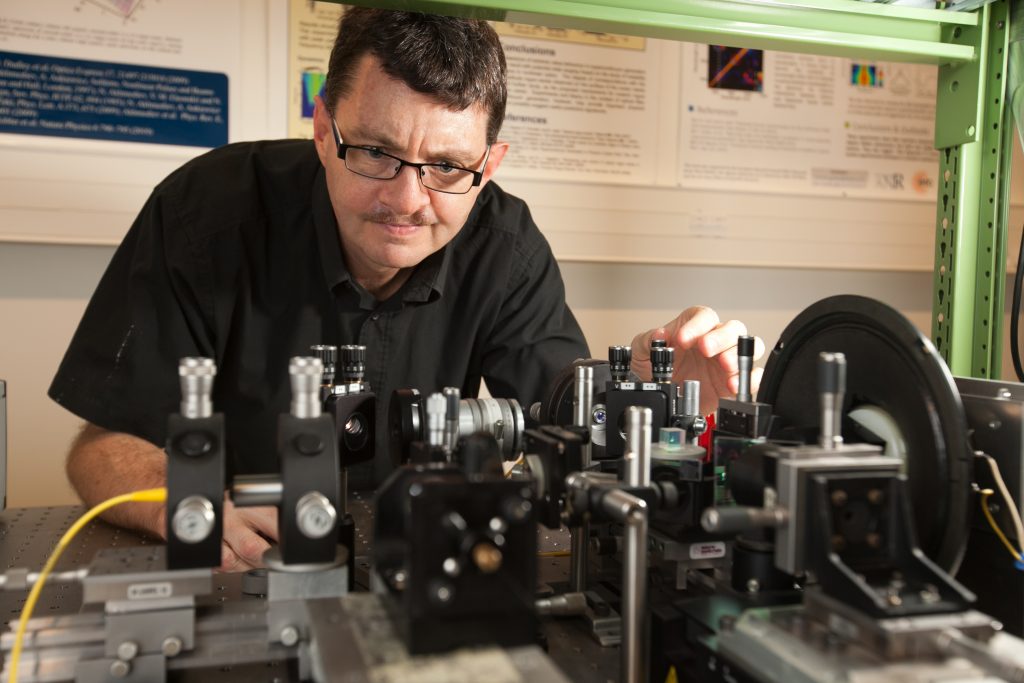Researcher’s portrait – ISITE-BFC fellowships

John Dudley, UBFC Senior fellowship laureate
A world-renowned researcher, John Dudley has made major contributions in the fields of ultrafast optics, supercontinuum generation and the science of rogue waves. He has published more than 500 contributions in journals and conference proceedings; his research has been cited over 10,500 times (ISI, excluding self-citations) and his h-index is 55/69 (ISI, Google Scholar). He has received a number of distinctions such as the Institute of Physics (IOP) President’s Medal (2016) and the Dwight Nicholson Medal of the American Physical Society (2017). In 2019, he received the Harold E. Edgerton Award of SPIE1 and in 2020 he received the R. W. Wood Prize of OSA2 for his contributions to nonlinear optics in optical fibre.
In addition to his research, he is an active member of several scientific societies and councils and has taught at all levels (in English and French), from large undergraduate lectures to specialised graduate courses.
1. On the second ISITE-BFC call for project, you applied for a UBFC Senior Fellowship. Could you please give us the main motives of your application?
The majority of research funding both in France and in Europe is for projects involving multiple partners, and while this approach is essential to promote collaboration, it necessarily leads to projects that are very tightly structured with a timetable defined in advance, and regular deliverables that are specified in very detailed terms.
As a result, my experience in recent years has been that such projects are less oriented towards basic research than they used to be, naturally focusing on more precisely-defined objectives.
The ERC3 has changed this completely of course and has been a tremendous success, renewing the culture of curiosity-driven research. The UBFC Senior Fellowship adopted exactly the same model, and it is this that motivated my application. At the time I applied, I was developing new experiments that I personally considered to be extremely significant, but they were high risk and unsuitable for traditional funding. The UBFC Senior Fellowship call appeared at exactly the right time to allow me to begin developing these ideas.
2. What are the assets of your project in view of the ERC grant ?
The laser was invented in 1960, and has truly revolutionized society. Most of what we take for granted today in areas such as communications and healthcare rely directly on laser-based technology. However, the basic approach to laser design has changed little in the last 60 years, and we are reaching the limits of what current developments can achieve.
New applications in areas such as sensing and imaging need a new kind of light source – one that is arbitrarily tunable over broad wavelength ranges, and able to generate short pulses or continuous light on demand. At present, however, it is necessary to design and build a new laser for every new application, which undeniably slows down the transfer of ideas to technology.
So my objective is to tackle this problem directly and to make a kind of “universal light source”. To do this, we are using results from other fields of physics such as hydrodynamics to understand (and hopefully overcome) limits on laser power, and we are applying concepts from artificial intelligence to optimize the laser operation. We aim to combine these different areas to yield both a new class of light source, as well as new insights into the fundamentals of laser operation. The combination of a new concept, multidisciplinary, and potentially new physics is one that fits well within the mandate of the ERC.
3. In your opinion, what would be the main strengths of the ISITE project run by UBFC?
In my view, the major strength of the ISITE-BFC programme is its structuring influence. There are tremendous resources within the various institutes and laboratories of UBFC, and combining these together under a common vision will naturally create new ideas and synergies. This said, individual researchers and professors are busy people, and it can be difficult to find the time to explore new directions when there is already so much to do. This is where ISITE-BFC can play a critical role in fostering an efficient environment for stimulating new dialogues – not only between permanent staff, but also between young researchers. This latter element is especially important, as it is generally from young people that the truly revolutionary new ideas emerge. Through its different mechanisms supporting research and industry, as well as through coordination with other projects such as the Graduate School EIPHI-BFC, ISITE-BFC is creating the foundations for regional excellence in research, both for today and the next generation.
1 SPIE : The international society for optics and photonics
2 OSA : The Optical Society
3 ERC : European Research Council






